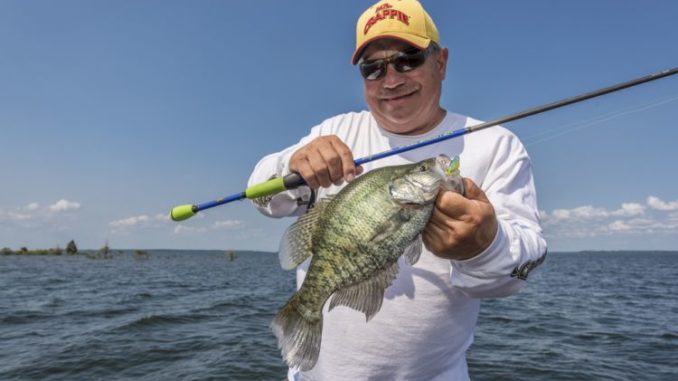
Jig up more crappie with these tried-and-true tactics
Seeing a school of crappie on your side-imaging electronics is one thing: Getting those fish into the boat is quite another.
But Wally “Mr. Crappie” Marshall has it figured out. Once fish are in their summertime pattern, he begins by using his Humminbird Helix units to identify submerged timber or submerged brush tops holding fish.
Throughout the summer, crappie will gang up around brush piles and standing timber. So at least they are predictable.
But then he has to convert that knowledge to hookups — and he almost never uses live bait. Here are his tips to boxing the fish you see on your depth finder using jigs.
1) Mark your spot — If you have a high-end Minn-Kota, you have a wonderful tool in the Spot-Lock feature, but Marshall said it’s still important to put out a marker to ensure you set up correctly.
“That gives you a reference point as you’re idling over the timber to mark the best spot,” he said.
Marshall often adjusts his position while fishing, and that marker keeps him from constantly having to re-locate the timber he’s fishing.
2) Shoot instead of casting — Marshall never casts his jig out, preferring instead to shoot the lure just like he would if he were probing deep under docks.
“I can be more accurate, and in the wind I can shoot it a lot easier than casting it,” Marshall said.
His signature Lew’s Speed Shooter rods are designed to maximize the shooting technique.
“I can actually shoot this rod 67, 69 feet,” Marshall said.
3) Don’t go too light — Ditch the 1/32- and 1/64-ounce jigheads, and replace them with 1/1/6-ounce models.
“I want something with a slow fall, but not too slow,” Marshall’s said.
4) Use 6-pound line — This line combines with Marshall’s jigheads to provide a very exact fall rate so the angler knows where he’s putting his lure.
“Six-pound line and that 1/16-ounce jig falls a foot a second,” he explained. “So if I’m marking fish at 15 feet, I just count down to them.
“If you use 8-pound line, it falls too slow; if you use 4-pound line, it falls too fast.”
5) Be a line watcher — A key is to shoot the jig past the timber and give it slack as you count down to the proper depth.
“When it drops, you’re watching that bow in the line,” Marshall said. “If you see it stop or jump, you have a fish.”
His favorite line is his own Mr. Crappie Hi-Viz green monofilament, which makes it very easy to see any tick on the business end of the line.
6) Don’t overwork the lure — One of the principle mistakes Marshall said many anglers make is jigging the lure too much.
“You want to just tick the end of your rod tip,” he said. “You just want to give the lure a little action.”
He twitches the rod tip and crawls the lure over the cover, eagle-eying the line for any sign of a bite.
7) Rig it right — It’s absolutely critical to ensure the lure mimics the little shad crappie munch on, and Marshall said that’s accomplished by correctly positioning the knot on the jighead eye.
“You don’t want that lure to hang vertical in the water; that’s not realistic,” he said. “So tie the knot tight, and then push it to the back of the hook eye. That will hold that lure horizontal.
8) Match lure color to the water — This is pretty basic, but worth keeping in mind.
“The clearer the water, the more natural the color,” Marshall said.
So shad colors, chartreuses and blues are his clear-water choices, with darker lures coming into play when the water is stained.
9) Find the sweet spot — This veteran panfisherman adjusts his boat position, throwing from different angles, until he catches a fish. He then hits Spot-Lock to hold his boat still.
“Every laydown, brush pile and standing timber has a sweet spot,” Marshall said. “Once you find that sweet spot, it’s over: Make the same cast, the same dip, and you’ll keep catching them.
10) Keep the action going — When a fish bites, quickly get another bait down to the school.
“Once you get that first bite, it will trigger the other fish in the school,” Marshall said. “But if you don’t get a bait down quickly, the fish will settle down and you’ll have to start over.”


